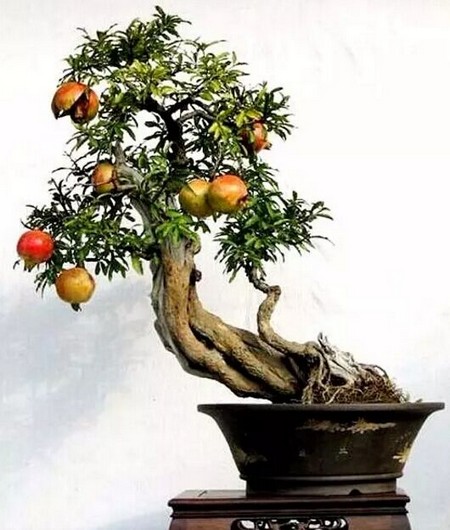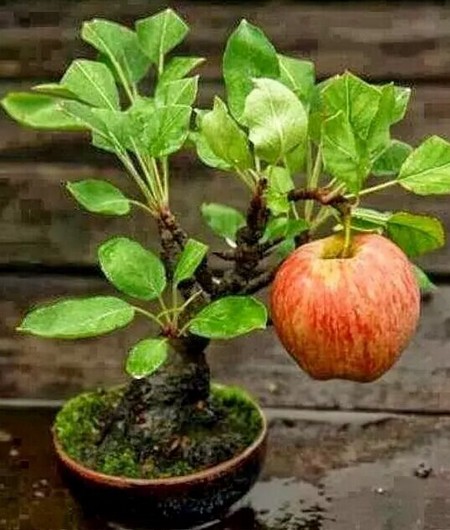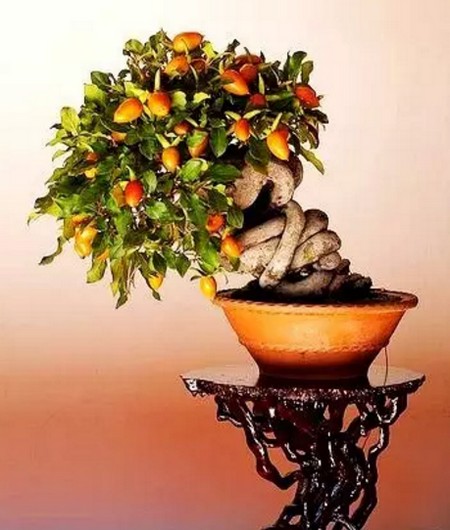Characteristics of Root System of Fruit Tree Bonsai
Potted fruits and vegetables have a long flowering period and beautiful shape, which can not only play the effect of greening, but also add more interest than greening. Put indoors, you can enjoy the whole process of blooming and fruiting of fruits and vegetables in a long time. Potted fruits and vegetables are not only summer varieties planted in the open, but also winter varieties planted in greenhouses and greenhouses. People can enjoy and taste fresh fruits and vegetables indoors all the year round.
The root system is not only an organ for fruit trees to fix and absorb nutrients and water, but also an organ for storage and synthesis of organic nutrients. Strong root system is the basis of normal growth and fruiting of bonsai fruit trees.

Under the pot condition, due to the centrifugal growth habit of the root system and the superior soil ventilation conditions near the basin wall, the root system grew around the basin wall and bottom, forming root cushions and root clusters. After 2-3 years, with the root elongation and the increase of root quantity, the root mass filled the basin. This aging root mass reduces the proportion of soil in the basin and directly affects the absorption and transport of nutrients. Therefore, it is necessary to change the basin in time, trim the root system and replace the new culture. The number of years of changing the basin should be flexibly controlled according to the growth of root and aboveground parts, usually 2-3 years.
Compared with the deep and wide root distribution of fruit trees in the field, the adaptability and resistance of pot trees to external environment, such as temperature and humidity, soil ventilation, fertilization concentration, harmful substances and diseases and insect pests were greatly reduced. Poor environmental conditions and improper management often lead to root damage, weakness and even death. When the growth of the potted tree is weak, the leaves become dark, yellow, lose luster, and the fruit is stunted or even shedding, we should first check whether the root system is damaged and take timely measures to remedy it.
If the root system of fruit tree meets its needs, it can grow continuously all the year round, and its growth peak often alternates with that of the crown, that is, there is a peak of root growth before each new shoot occurs or before the new shoot speed for a long time. The occurrence of roots in this period has a direct impact on the growth of new shoots. The roots of fruit trees have a strong ability of regeneration, and after cutting off, it is easy to grow a large number of new roots near the wound. The factors affecting root growth and absorption are as follows.
1. Temperature. In general, the root system of fruit trees began to move above 0 ℃, the optimum temperature for growth was 15-25 ℃, and the growth was inhibited when the soil temperature exceeded 30 ℃. With different tree species, the temperature requirements of roots are also different. For example, apple roots began to grow at 1-2 ℃, and 14-21 ℃ was the optimum temperature for growth, while citrus roots began to grow at about 12 ℃, the optimum temperature was about 26 ℃, and the highest temperature for growth was 37 ℃. After thawing in early spring, the roots of potted trees such as apple, pear, peach and Hawthorn began to grow, and a large number of new roots appeared before the rapid growth of new shoots. The new roots of citrus, persimmon, jujube and some southern fruit trees occurred late in spring, and the root system grew slowly. In winter, the root system of northern deciduous fruit trees is in a state of resting eyes, and only maintains the lowest physiological activity. Similarly, the root activity of southern evergreen fruit trees overwintering in greenhouse is relatively weak in winter. The cold resistance of root system is related to the heredity of tree species. It is related to the level of storage nutrition in the same tree species. The perennial roots with strong roots have strong cold resistance. Under the same overwintering conditions, young trees in the new pot are easy to strip or even freeze to death, which should be protected during cultivation. The pot trees placed on the cement floor on the balcony, roof, front steps and so on in summer, because of the local high temperature fumigation and the heat conduction of the cement floor, the basin soil temperature is often too high and damage the root system, especially when the crown is small. this situation is more serious when the shielding degree of potted trees is poor or the soil moisture is low. It can be adjusted by means of ground water spraying and basin bottom humidification pad.
2. Moisture. The water content of basin soil, which is most suitable for root growth, is about 60% of the maximum soil water holding capacity. 80%. The drought resistance of roots is much lower than that of leaves. Under drought conditions, leaves get a lot of water from the roots, resulting in root damage and even death. Due to the limitation of basin soil capacity and large loss area, the loss rate of water in the basin is 4-5 times higher than that of topsoil in field orchard. Negligence in management can easily lead to water loss. The smaller the basin, the larger the crown, the higher the temperature, the sunnier and drier the climate, especially in the hot and dry wind season, the faster the rate of water loss, the more attention should be paid to replenishing water to the basin in time.
3. Ventilation. The physical structure of basin soil is composed of soil particles and pores, small capillary pores are occupied by water, and large non-capillary pores are occupied by emptiness. The respiration, growth and other physiological activities of fruit tree roots require adequate oxygen supply in the basin soil. Under the condition of hypoxia in the basin soil, the normal respiration and physiological activities of fruit trees were blocked, and the growth stopped. At the same time, the accumulation of carbon dioxide and other harmful gases caused root poisoning, resulting in root death. The most suitable soil composition for the growth of fruit trees is that soil pores account for about 50% of the total bulk density of the soil, and the water and air in the pores account for about half.
The aeration and permeability of potted nutritious soil (referred to as permeability) indicates the proportion of soil pores. When preparing, the materials can be selected according to local conditions, and can be adjusted appropriately according to different tree species and pots. For example, the root system of peach has strong respiration, high oxygen consumption and high permeability to basin soil, while the root system of jujube is not very strict on oxygen and can adapt to clay heavy culture soil with poor ventilation. The wall permeability of the bonsai basin with purple sand or hanging glaze is far less than that of the plain burning basin made of clay, so the permeability of the basin soil should be increased. In addition, the raw materials are different in different places, so the preparation of nutritious soil should be adjusted flexibly according to the physical properties of the raw materials.
4. Nutrition. The growth and development of root system is related to the supply of soil nutrients and aboveground photosynthate. "Deep Root" and "Ye Mao" are mutually causal and mutually reinforcing relations. For example, when the potted trees bear too much fruit and the supply of photosynthates exceeds the demand, the root growth is obviously weak, but taking reasonable fruit retention measures to reduce aboveground nutrient consumption can obviously promote root growth. Similarly, taking leaf protection measures and foliar fertilizer spraying for sick and weak trees can not only promote leaf function, but also promote the growth of roots.
5. The acidity and alkalinity of basin soil. The pH value of soil directly affects the growth and absorption of roots. In the basin soil with high acidity, the absorption capacity of roots to elements such as phosphorus, calcium and magnesium decreased. In the basin soil with strong alkalinity, the absorption of manganese, iron and zinc by roots was blocked. Most fruit trees prefer the environment of micro-acid-neutral-micro-alkali (pH value 6.57.5). Excessive acid or alkali in basin soil may lead to element deficiency, affecting the growth and fruiting of fruit trees. However, different tree species have different requirements for the acidity and alkalinity of basin soil, which should be paid attention to when preparing soil.
Time: 2019-05-25 Click:
- Prev

Five characteristics of bonsai of fruit trees
Bonsai of fruit trees is the product of the combination of modern fruit tree cultivation techniques and traditional bonsai art, which integrates flower appreciation, fruit viewing and scenery viewing, so that the beauty of form and richness can be displayed at the same time. The flowers and branches are delicate and beautiful in spring, the summer is full of vitality, and the crisp fruit changes with each passing day, and the golden autumn fruit is colorful.
- Next

Growth characteristics of bonsai branches of fruit trees
Branch is an important part of crown and tree shape. It not only produces leaves, flowers and fruits, transports water and nutrients, but also plays an important role in nutrient storage. Sturdiness and sturdiness is an important guarantee for potting trees to bear fruit year after year. Some fruit tree branches can produce adventitious roots under suitable conditions.
Related
- Fuxing push coffee new agricultural production and marketing class: lack of small-scale processing plants
- Jujube rice field leisure farm deep ploughing Yilan for five years to create a space for organic food and play
- Nongyu Farm-A trial of organic papaya for brave women with advanced technology
- Four points for attention in the prevention and control of diseases and insect pests of edible fungi
- How to add nutrient solution to Edible Fungi
- Is there any good way to control edible fungus mites?
- Open Inoculation Technology of Edible Fungi
- Is there any clever way to use fertilizer for edible fungus in winter?
- What agents are used to kill the pathogens of edible fungi in the mushroom shed?
- Rapid drying of Edible Fungi

